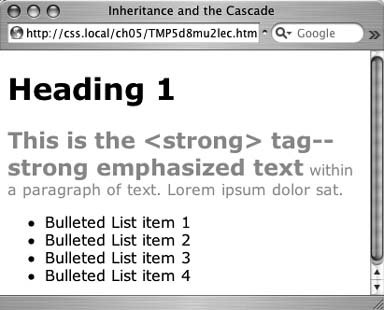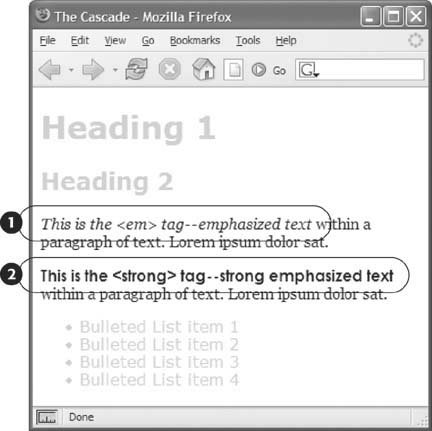Section 5.1. How Styles Cascade
5.1. How Styles CascadeThe cascade is a set of rules for determining which style properties get applied to an element. It specifies how a Web browser should handle multiple styles that apply to the same tag, and what to do when CSS properties conflict. Style conflicts happen in two cases: through inheritance when the same property is inherited from multiple ancestors , and when one or more styles apply to the same element (maybe a <p> tag style in an external style sheet and another <p> tag style in an internal style sheet). 5.1.1. Inherited Styles AccumulateAs you read in the last chapter, CSS inheritance ensures that related elementslike all the words inside a paragraph, even those inside a link or another tagshare similar formatting. It spares you from creating specific styles for each tag on a page. But since one tag can inherit properties from any ancestor taga link for example, inheriting the same font as its parent <p> tagdetermining why a particular tag is formatted one way can be a bit tricky. Imagine a font applied to the <body> tag, a font size applied to a <p> tag, and a font color applied to an <a> tag. Any <a> tag inside of a paragraph, would inherit the font from the body and the size from the paragraph. In other words, the inherited styles combine to form a hybrid style. The page shown in Figure 5-1 has three styles: one for the <body>, one for the <p> tag, and one for the <strong> tag. The CSS looks like this: body { font-family: Verdana, Arial, Helvetica, sans-serif; } p { color: #999999; } strong { font-size: 24px; } The <strong> tag is nested inside a paragraph, which is inside the <body> tag. That <strong> tag inherits from both of its ancestors, so it inherits the font-family property from the body and the color property from its parent paragraph. In addition, the <strong> tag has a bit of CSS applied directly to ita 24px font-size. The final appearance of the tag is a combination of all three styles. In other words, the <strong> tag appears exactly as if you'd created a style like this: strong { font-family: Verdana, Arial, Helvetica, sans-serif; color: #999999; font-size: 24px; } 5.1.2. Nearest Ancestor WinsIn the previous example, various inherited and applied tags smoothly combined to create an overall formatting package. But what happens when inherited CSS properties conflict? Think about a page where you've set the font-color for both the body and paragraph tags. Now imagine that within one paragraph, there's a <strong> tag. Which color gets applied to text inside the <strong> tag? The color inherited from the body or the paragraph? Ladies and gentleman, we have a winner: the paragraph. That's because the Web browser obeys the style that's closest to the tag in question. Figure 5-1. Thanks to inheritance, it's possible for multiple styles to affect the appearance of one tag. Here the <strong> tag has a specific color, font-family, and font size, even though only a single property is applied directly to that tag. The other two formatting options were inherited from the tag's ancestors: the <body> and the <p> tags. In this example, any properties inherited from the <body> tag are rather generic. They apply to all tags. A style applied to a <p> tag, on the other hand, is much more narrowly defined. Its properties apply only to <p> tags and the tags inside them. In a nutshell , if a tag doesn't have a specific style applied to it, then in the case of any conflicts from inherited properties, the nearest ancestor wins (see Figure 5-2, number 1). Here's one more example, just to make sure the concept sinks in. If a CSS style defining the color of text were applied to a <table> tag, and another style defining a different text color were applied to a <td> tag inside that table, then tags inside that table cell (<td>) such as a paragraph, headline, or unordered list would use the color from the <td> style, since it's the closest ancestor. 5.1.3. The Directly Applied Style WinsTaking the "nearest ancestor" rule to its logical conclusion, there's one style that always becomes king of the CSS family treeany style applied directly to a given tag. Suppose a font-color's set for the body, paragraph, and strong tags. The paragraph style is more specific than the body style, but the style applied to the <strong> tag is more specific than either one. It formats the <strong> tags and only the <strong> tags, overriding any conflicting properties inherited from the other tags (see Figure 5-2, number 2). In other words, properties from a style specifically applied to a tag beat out any inherited properties. This rule explains why some inherited properties don't "appear" to inherit. A link inside a paragraph whose text is red still appears browser-link-blue. That's because browsers have their own predefined style for the <a> tag, so an inherited text color won't apply. Figure 5-2. Here's how Web browsers figure out which properties to display when inherited properties conflict: The <em> tag in the first paragraph (1) inherits the font-family from both the <body> tag and the paragraph. But since the body and paragraph have different fonts applied to them, the <em> tag uses the font specified for its closest ancestorthe <p> tag. When a style applies directly to a tagthe font-family is specified for the <strong> tag (2)browsers ignore conflicting inherited properties. Tip: You can learn how to overcome preset tag styles, and change link colors to your heart's content. See Section 9.1 for the solution. 5.1.4. One Tag, Many StylesInheritance is one way that a tag can be affected by multiple styles. But it's also possible to have multiple styles apply directly to a given tag. For example, say you have an external style sheet with a <p> tag style and attach it to a page that has an internal style sheet that also includes a <p> tag style. And just to make things really interesting, one of the <p> tags on the page has a class style applied to it. So for that one tag, three different styles directly format it. Which styleor styles should the browser obey? The answer: It depends. Based on the types of styles and where they come from, a browser may apply one or more of them at once. Here are a few situations in which multiple styles can apply to the same tag:
If more than one style applies to a particular element, then a Web browser combines the properties of all those styles, as long as they don't conflict . An example will make this concept clearer. Imagine you have a paragraph that lists the name of the Web page's author, including a link to his email address. The HTML might look like this: <p class="byline">Written by <a href=" mailto:jean@cosmofarmer. com ">JeanGraine de Pomme</a></p> Meanwhile, the page's style sheet has three styles that format the link: a { color: #6378df; } p a { font-weight: bold } .byline a { text-decoration: none; } The first style turns all <a> tags powder blue; the second style makes all <a> tags that appear inside a <p> tag bold; and the third style removes the underline from any links that appear inside an element with the byline class applied to it. All three styles apply to that very popular <a> tag, but since none of the properties are the same, there are no conflicts between the rules. The situation is similar to the inheritance example above (Section 5.1.1): the styles combine to make one ¼berstyle containing all three properties, so this particular link appears powder blue, bold, and underline-free. Note: Your head will really start to ache when you realize that this particular link's formatting can also be affected by inherited properties. For example, it would inherit any font-family that's applied to the paragraph. A few tools can help sort out what's going on in the cascade. (See the box in Section 5.2.1.) |
EAN: 2147483647
Pages: 154
- Article 220 Branch-Circuit, Feeder, and Service Calculations
- Example No. D1(a) One-Family Dwelling
- Example No. D4(b) Optional Calculation for Multifamily Dwelling
- Example No. D10 Feeder Ampacity Determination for Adjustable-Speed Drive Control [See 215.2, 430.24, 620.13, 620.14, 620.61, Tables 430.22(E), and 620.14]
- Example No. D12 Park Trailer (See 552.47)